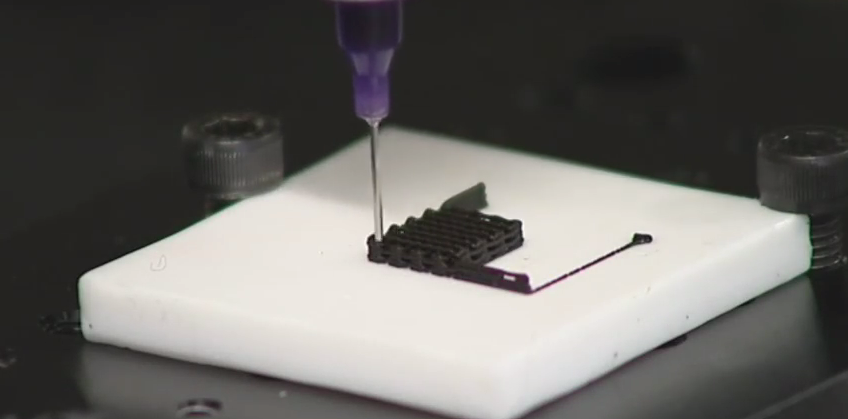 We’ve seen an incredible amount of research hours and dollars being poured into an area where the ‘miracle material’ graphene converges with what some may call a ‘miracle technology’ in 3D printing. In this space, a whole slew of groundbreaking applications and processes may emerge as a better understanding of graphene, and how to 3D print it come about.
We’ve seen an incredible amount of research hours and dollars being poured into an area where the ‘miracle material’ graphene converges with what some may call a ‘miracle technology’ in 3D printing. In this space, a whole slew of groundbreaking applications and processes may emerge as a better understanding of graphene, and how to 3D print it come about.
We’ve discussed a company called Graphene 3D Lab in the past. They have been producing a graphene nanocomposite filament for typical FDM/FFF 3d printers. The problem with this filament, however, is the fact that most of the desirable properties of graphene, such as strength and weight, are lost since the graphene is usually mixed with a thermoplastic material. The only real useful property that remains is conductivity.
Back in December we also uncovered research being done by a group led by Seol Seung-kwon at the Korea Electrotechnology Research Institute’s Nano Hybrid Technology Research Center (KERI), which concentrated on using a graphene oxide formula to print with, which resulted in pure graphene structures once the material was processed. According to the researchers they believed that such a process would be commercially available in only a few short years.
It appears as if the South Korean group is not alone in their research centering around the 3D printing of a graphene oxide material, as a group of researchers led by Dr. Esther García-Tuñon, a Research Associate at the Centre for Advanced Structural Ceramics at Imperial College London (ICL) have devised another method to this approach. In a paper published on January 21, 2015, in Advanced Materials, the researchers outlined this technique.
The method described relies on a graphene oxide paste consisting of graphene oxide along with a responsive polymer, which is able to change its behavior and structure when a ‘chemical switch’ is activated.
“Our formulations have the flow and physical properties we need for the filament deposition process required in 3D printing: They need to flow through very small nozzles and set
immediately after passing through it, retaining the shape and holding the layers on top,” Dr. Esther told Nanowerk. “We use this two-dimensional material as building block to create macroscopic 3D structures and a technique called direct ink writing (DIW) also known as direct write assembly (DWA), or Robocasting.”
The material used can be extruded out of a nozzle as small as 100 micron, meaning that very intricate objects are possible to print. The goal of the researchers is to 3D print pure graphene structures, not structures consisting of other materials mixed with graphene. The way this process works is that graphene oxide (chemically modified graphene) is extruded in paste-form to fabricate an object. Once the print is completed the object is treated thermally so that it recovers it’s pure graphene form. The next obvious step would be to scale this process up, as well as create new formulas for a variety of possible applications from oil absorption to flexible electronics.
“I think there are still many challenges to overcome in both Additive Manufacturing and graphene technologies,” explained García-Tuñon. “The buzzword 3D printing is now everywhere; we can find many examples of commercially available 3D printers to make your own Hello Kitty, iPhone cases, and all sort of plastic models. But there is still a long way to go from here to the use of 3D printing for a wide variety of materials in multicomponent and practical devices.”
With so many groups concentrating their efforts on the 3D printing of graphene, there’s no doubt we are getting closer to commercial graphene printing. When that happens many industries may be turned upside down, including areas within solar energy, aerospace, and electronics.
Let’s hear your thoughts on this work being done. Discuss in the 3D Printed Graphene forum thread on 3DPB.com. Check out the video below of Dr. Esther explaining her research:
Subscribe to Our Email Newsletter
Stay up-to-date on all the latest news from the 3D printing industry and receive information and offers from third party vendors.
You May Also Like
3D Printing Unpeeled: Biofuel Waste to Filament & Sustainable Photopolymers
I can’t ever remember a day with so many potentially high impact news stories have come out. In one story, we all know that there are problems with the safety...
Finnair Hires AM Craft to 3D Print Plastic Parts for Aircraft Interiors
Riga-based AM Craft, a supplier specialized in 3D printing aviation components and certified under EASA Part 21G, announced a significant achievement today. The company will assist in upgrading Finnair’s A320...
3DPOD Episode 198: High Speed Sintering with Neil Hopkinson, VP of AM at Stratasys
Neil Hopkinson, a pioneering 3D printing researcher, played a pivotal role in developing a body of research that is widely utilized today. He also invented High Speed Sintering (HSS), also...
3D Printing Webinar and Event Roundup: May 12, 2024
Webinars and events are picking up in the AM industry this week! ASTM International continues its Professional Certificate Course and Stratasys continues its advanced in-person trainings, while 3D Systems is...

































